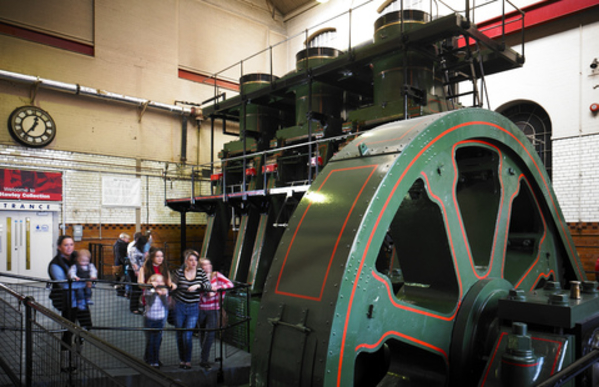Sheffield puts the steel into beer
Added: Monday, November 25th 2019

Sheffield is a special place for good beer and good pubs. I was bowled over by the Steel City beer festival in October held at the Kelham Island Industrial Museum that celebrates the city’s key role during the Industrial Revolution. As well as a fine range of beers for the festival, the halls are a permanent home to some of the mighty machines that forged steel and cutlery and made Sheffield famous internationally.
In between giving talks and tastings I made a short journey to Hop Hideout, a superb beer shop run by Jules Gray and her partner Will (below). Jules previously worked in the brewing industry and has an enviable knowledge of beers from around the world.
Jules’s shop is in a complex called Kommune on Angel Street, a former Co-op supermarket that now has several restaurants, a book shop and Hop Hideout. Jules had invited me to a question and answer session where I could be asked about my career as a beer writer, my favourite beers and my current work.
The liveliest part of the session centred on a discussion about lost beers, with the audience chipping in with the ales they had loved and were no longer with us. Boddingtons Bitter was high on the list. The exceptional beer from Manchester had the misfortune to be taken over by Whitbread, then passed to AB InBev, who closed the brewery.
We also mourned the loss of Ind Coope and its Draught Burton Ale, Eldridge Pope, Morrells of Oxford, Ridley and, given the venue, Wards of Sheffield. I chipped in with Draught Bass, which is not lost but is hanging on by its finger tips.
I mentioned the beer as I had been struck by the fact that the 2020 edition of the Good Beer Guide lists just one pub in the whole of London that still serves the beer. As a comparison, I plucked the 1989 edition from my book shelf and found the London section was packed with pubs serving Draught Bass.
The beer is truly one of the great ales of old England, a direct descendant of the celebrated pale ales and IPAs of Burton-on-Trent. When I first started writing about beer, as I told the Hop Hideout audience, and was asked to name my favourite beer I always replied “Draught Bass”. Unlike many modern pale ales, it’s a superbly well-balanced beer, a synthesis of biscuit malt and spicy hops with a touch of sulphur from the waters of the Trent Valley.
In its pomp it was worth 800,000 barrels a year and it was without question the biggest-selling premium cask beer in the country. Today production is rumoured to be around 35,000 barrels and the beer is as hard to find as the proverbial rocking horse droppings .
The explanation for this fall from grace lies in the twisted priorities of global brewing behemoths such as AB InBev. It says it can’t be bothered with low volume beers and has hived off the production of Draught Bass to Marston’s. At least it’s still brewed in Burton and Marston’s make a good fist of it.
Meanwhile AB InBev or Budweiser Brewing as they now prefer to be known – and personally I’d keep quiet about that – has re-launched bottled Bass Pale Ale that’s brewed in a giant mega-keggery in Samlesbury in Lancashire. The beer is mediocre and no longer bottle conditioned. The label, incongruously, calls it “Imported Pale Ale”. This is rowlocks of the first water.
If you want to drink Draught Bass in London then hurry to the single GBG entry, the Express Tavern on Kew Bridge Road. The words Draught Bass are emblazoned on the exterior complete with the famous Bass red triangle trademark. Inside the 18th-century coaching inn there are large mirrors, old photos of the area and the pub, good food and magnificently kept pints of the great and noble ale.
And while you’re on your travels, make a note in your diaries to visit the Steel City festival next year and drop into Hop Hideout for a beer and a chat with Jules.
First published in What’s Brewing, December 2019









